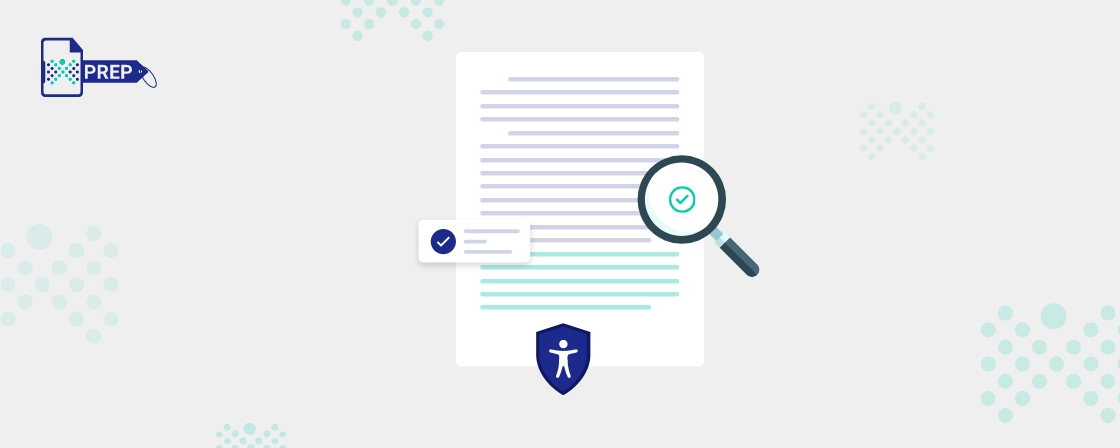Key Takeaways
- PDF Accessibility is essential to ensure that all readers, including those with visual or mobility impairments, can access information.
- A well-designed table of contents can significantly enhance the reading experience for all users, but it’s essential for individuals with visual impairments.
- Reflowable content allows readers to adjust the font size, style, and color to suit their needs, making it especially helpful for people with low vision or dyslexia.
- Headings can signal the beginning of a new section, and following a proper hierarchy for headings makes navigating the content easier for assistive technologies like screen readers.
- Adding alt text to images is essential to make them accessible for visually impaired users.
- To ensure that your EPUB document is accessible to everyone, including those with disabilities, use MathML to mark up mathematical equations.
- It’s important to ensure that the color contrast in your PDFs meets accessibility guidelines, with a minimum ratio contrast of 4.5:1 recommended.
Introduction
PDF Accessibility is essential for ensuring that all readers, including those with visual or mobility impairments, can access information in today’s digital age. Assistive technologies like screen readers, Braille displays, and screen magnification software have easily enabled everyone to navigate through documents like technical manuals and marketing brochures.
To ensure that your PDFs are accessible to all readers, it’s essential to prioritize PDF Accessibility in their creation. This not only benefits people with disabilities but also provides a flexible user experience for everyone. This article will give helpful tips for creating accessible PDFs for Electronic Publication (EPUB) projects, allowing you to reach the widest audience possible and ensuring that your content is inclusive and accessible to all.
Table of Contents
Use Proper Layout and Structure
Make Content Readable
Media Accessibility
Use MathML for Equations
Color Contrast Accessibility
Add Bookmarks and Hyperlinks
Adding bookmarks and hyperlinks to your EPUB documents can make them more accessible and easier to navigate. Bookmarks allow readers to quickly jump to different document sections, while hyperlinks provide additional information and resources. Ensure all links are descriptive and use clear, straightforward language for maximum accessibility.
Footnotes and Endnotes, "Return to Text" Links
Adding Standard Accessibility to Your EPUB
- Metadata: Include metadata at the beginning of the file to indicate that your publication is accessible and contains the following accessibility features:
- The title of the publication
- The language used and the date when your content was last modified
- The author of the EPUB
- The publishing organization of the EPUB and the date of creation
- Alt-text Descriptions: When including images in your document, make sure to add alt-text descriptions that accurately describe the image. Avoid embedding text in images as it makes it difficult for the screen reader to read the content aloud. You can prepare the alt text descriptions using a spreadsheet and paste them into the <“alt=”> tag inside each image file in the HTML of your content.
- Navigation: Ensure that users can easily navigate your content by editing the OPF (Packaging document) manifest and spine. The manifest lists all files within the ePub directory, and the spine identifies the reading order of all manifest contents.
- Semantic HTML Markup: Add semantic HTML markup to the content to identify discrete text sections. Use <section> code for chapters and <aside> code for sidebars.
- Font Embedding: Embed various fonts in a single EPUB file so that users with different needs can select a font that meets their requirements.
How to Create Accessible PDFs for Large-Scale Publishing Projects using PREP
PREP is an advanced AI-based PDF remediation platform that efficiently produces large volumes of accurately tagged accessible PDFs for extensive publishing projects quickly. Its 70% automated remediation process reduces turnaround time despite the document’s complexity.
Digital PDF files are frequently incompatible with online publishing requirements. Still, PREP can seamlessly transfer PDFs to multiple preferred formats like HTML, DOCX, or ePub without compromising its original form and structure. Users can access and modify content quickly and efficiently by converting PDFs to DOCX format. Therefore, PREP is the ideal solution for large-scale publishing projects requiring document digitization.
PREP is compliant with ADA/WCAG 2.1 AA standards, making it easier for the publishing industry to meet accessibility standards by making textbooks, ancillaries, educational material, and documents fully accessible to users.
Final Thoughts:
Transform with Affordable Document Remediation
Experience top-tier PDF remediation powered by AI, delivering unmatched quality, precision, and scalability, all at a fraction of traditional time and cost.
